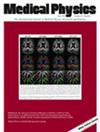Robust Fourier-based slanted-edge method to measure scatter ratio
Abstract
Background
Patient scatter incident on an x-ray detector reduces radiographic contrast and adds quantum noise, and minimizing scatter is critical in some specialized techniques such as dual-energy and energy-subtraction methods. Existing methods to measure scatter are either labor-intensive (multiple disks) or not appropriate to use in radiography where scatter often exceeds the width of the x-ray beam.
Purpose
Develop a method to measure the scatter-to-primary ratio (SPR) that can be used for a wide range of radiographic and mammographic conditions, both with scatter equilibrium (scatter function does not exceed primary-beam width) and without.
Methods
Fourier theory is used to show the SPR can be measured from the low-frequency drop (LFD) of the Fourier transform of the derivative of a normalized edge profile. The method was validated both experimentally and by simulation for radiography and mammography under scatter equilibrium and nonequilibrium conditions.
Results
The theoretical derivation showed that by normalizing an edge profile with a profile without the edge, scatter equilibrium is not required and the method accommodates a nonuniform primary beam from beam divergence and Heel effect. The method was validated by a simulation study for a range of scatter-LSF widths, primary-beam widths, and image regions of interest used in the analysis. Experimental scatter measurements agreed with a similar edge-method published by Cooper when scatter equilibrium is achieved.
Conclusions
A simple and direct method of measuring the SPR obtained with both uniform and nonuniform test phantoms is described. Validated both experimentally and theoretically, it uses the Fourier LFD obtained from a normalized slanted-edge profile and works for a wide range of practical mammographic and radiographic conditions.


 求助内容:
求助内容: 应助结果提醒方式:
应助结果提醒方式:


